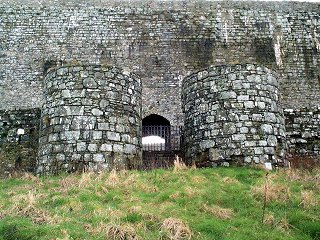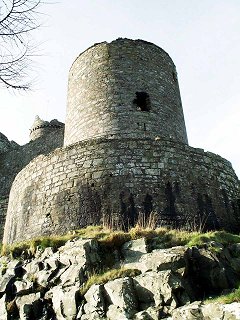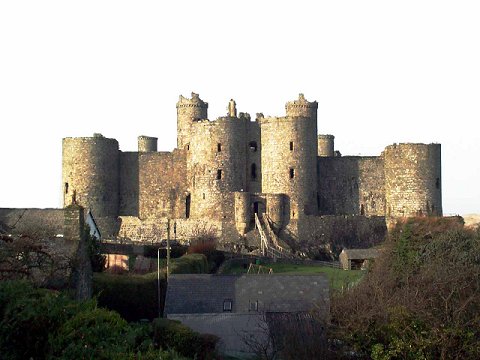Harlech Castle
In 2004 I appeared in a television programme for the History Channel on Master James St Geroge and Harlech and Rhuddlan castles. The text below explains what was known about Harlech then. This 'research' although based upon primary documents, had not taken in the whole picture. As a result the conclusions were widely at variance with what should have been arrived at. This information is left here for the student of history to ponder upon before they press the following links to take them to what we know today about the real Harlech Castle and its True Origins and the foundation of Harlech castle.
The State of Knowledge in 2004Harlech is a well known fortress built on a crag overlooking Cardigan Bay. The castle still stands virtually complete except for its slighted battlements and is renowned for being one of the most photogenic castles of Master James St George and King Edward I in Wales.
Harlech castle was founded in April 1283 by 560 infantry led to the site by Otto Grandison. Otto’s brother, William Grandison (1245-1335), lies buried under a superb military effigy in Hereford cathedral. On 21 May 1283 ten masons and quarriers were sent from Conway to the building works at Harlech. They came complete with a packhorse given them for two days to carry their tools. Then between 17 and 20 August King Edward I surveyed the castle site whilst work continued costing approximately £100 per month during the summer. On his departure, King Edward left five household knights in charge of the building, John Cosyn, Ebulo Montibus, John Gayton, John Exchequer and Peter Cornhill. It is noticeable that the first two of these men were Savoyards who were so important in Edward’s building campaigns, while the last two men had names connected with the powerful English Exchequer. Gayton is a common English village name.

As the building work at Caernarvon and Conway wound down as these fortresses neared completion, the work at Harlech speeded up as more money was available. During 9½ months in 1286 some £1,500 was spent at the fortress while up to 900 men were busy carrying and building. The work during 1286 included the spiral stairs, arrow slits, string coursing, chimneys and ‘wood and thatch’ roofing for the internal buildings.
In November 1287 Master James St Georges left Wales for Gascony. It would seem likely that the plan of Harlech was by then well-known to the remaining masons and its completion was left in the hands of local men whilst James was away. This led to the big payments of 1289 which probably covered the work done up to then when Master James returned and paid for what he was satisfied with; viz
the north-west tower had been built by Master William Droghda at £111 plus £11 for the turret or garret on top of it.
The same William received £7 for a mantlet wall between that tower and the sea.
He also received £117 for the south-west tower and £11 for its turret.
He had also built a turret over the way to the sea, 23 feet of the north-east tower below the curtain wall for £63 and 14 feet above the curtain for an unrecorded sum.
Hugh Wem had built ten feet of the south-east tower for £6.
Thickening of the seaward curtain wall had cost £100 and battlmenting it and adding a turret and windows a further £25. The base of this curtain turret was still visible in 1742 when it was drawn by the Buck brothers. It shows a typical Savoyard turret overhanging centrally on the wall, rather like the latrine turret on the east outer curtain wall.
Master Ralph Ocle was paid nearly £125 for making the defended path from the sea to the castle with the wall enclosing it.
John the carpenter received £17 for 423 joists and £22 for roofing the south-east tower.
William the plumber received £35 for roofing the gatehouse and the western towers with lead. He also received £10 for thirty carrats of lead for doing this as well as roofing the kitchen, hall, chapel and pantry.
In total Harlech castle cost the king some £9,500 and took 7½ years to build.

Between 1403 and 1409 the castle was held by Owain Glyndwr, its constable, Edmund Mortimer, starving to death rather than surrender the castle back to the young Prince Hal, later to be King Henry V.
Between 1461 and 1468 the castle was held by the Lancastrians against the Yorkists. This traditionally gave rise to the song ‘Men of Harlech’. In July and August 1468 fifty men under Dafydd ab Ieuan ab Einion held off 7,000 Yorkists for a month until they surrendered on 14 August.
In the civil war the siege of Harlech lasted from June 1646 until 15 March 1647. This was longer than the siege of Rhuddlan which was also not attacked as it was so powerful. With command of the seas, as in 1403, 1409 and 1468 the castle was simply starved out. At its surrender Harlech castle was held by just sixteen officers and 28 soldiers.

The pictures above were taken during the filming of ‘The Masters - James St Georges for Circlevision’ by Paul Remfry and John Macnish on 11 February 2004. Please contact for further details about the programme.
A total re-examination of these 'facts'
has been undertaken and the corrections to this can be seen by clicking on the following
link: Harlech Castle and
its True Origins
